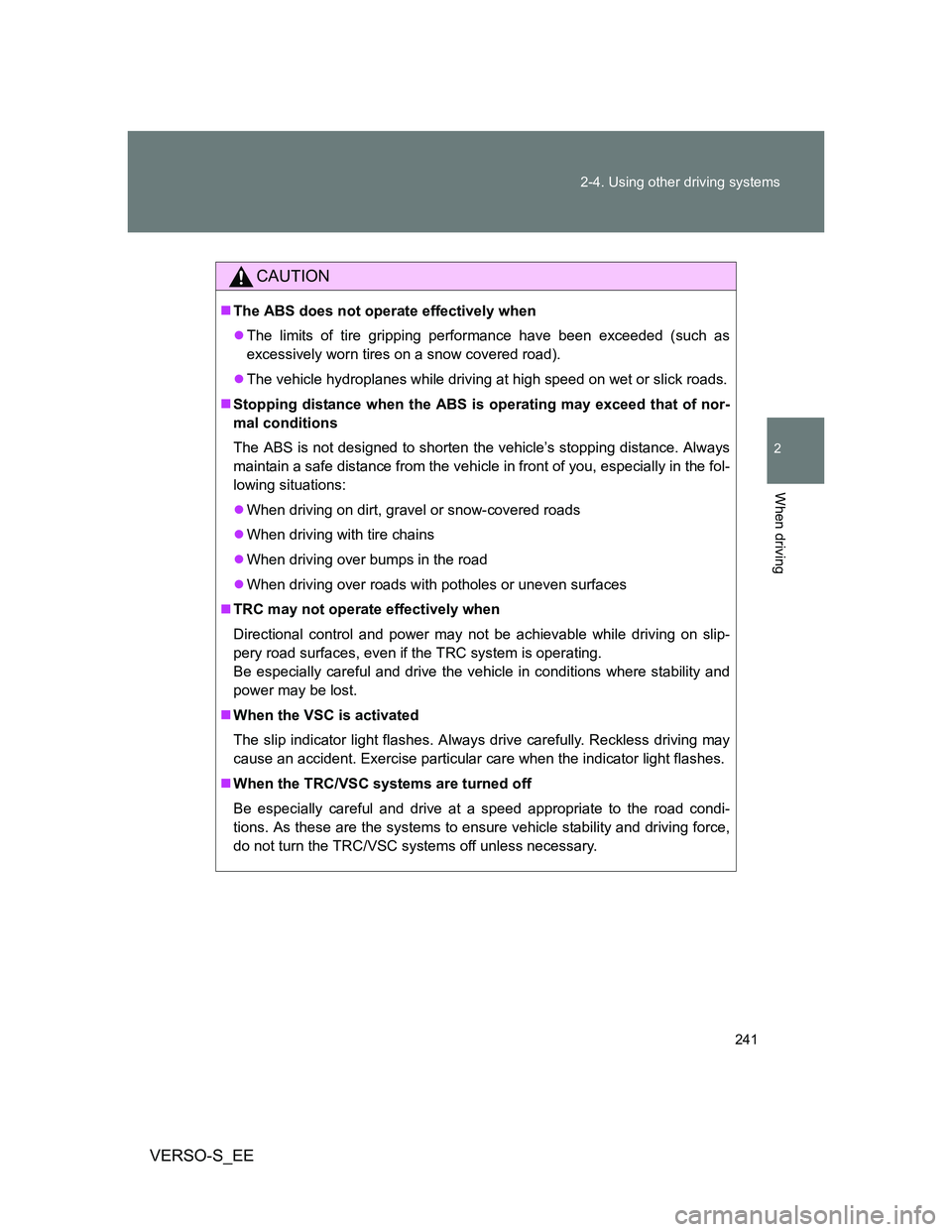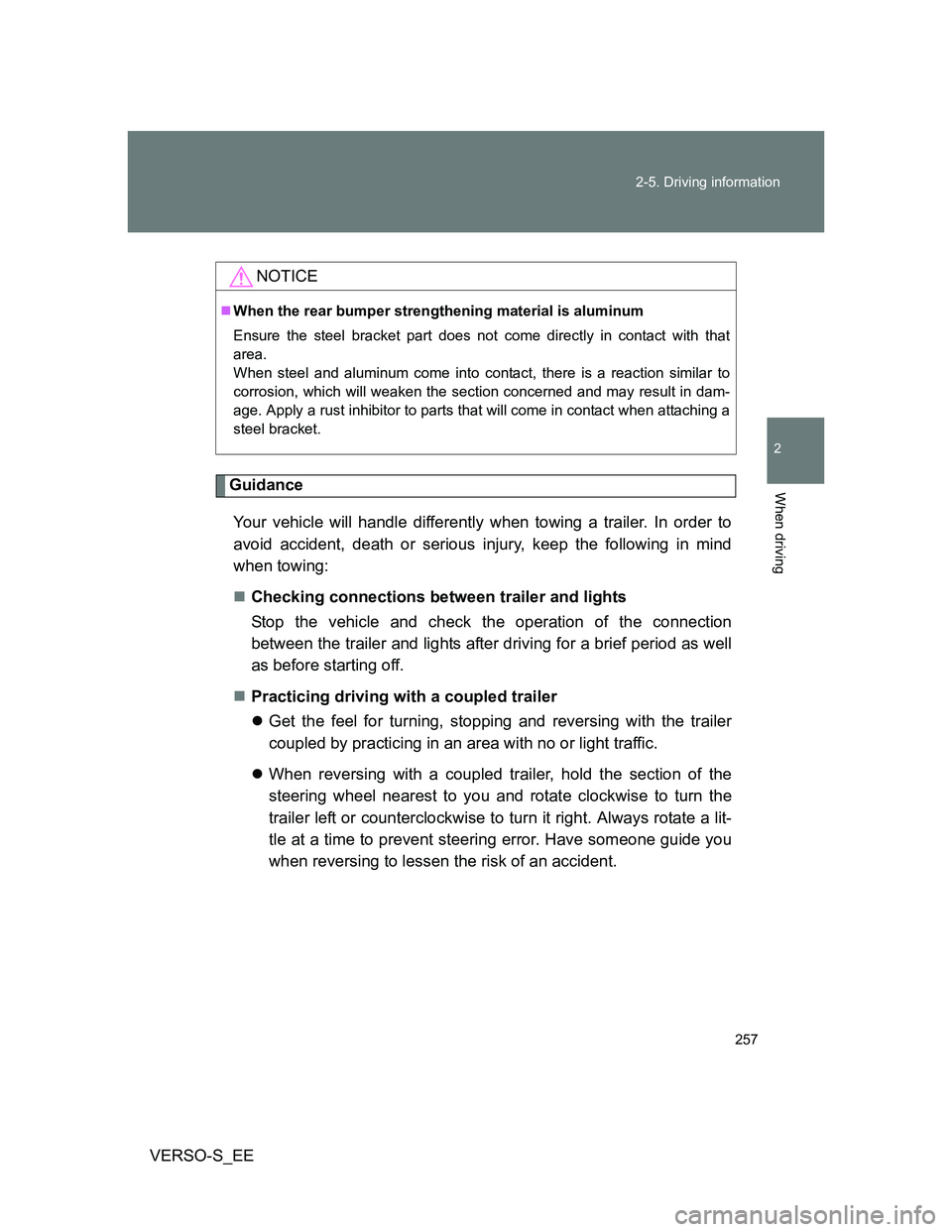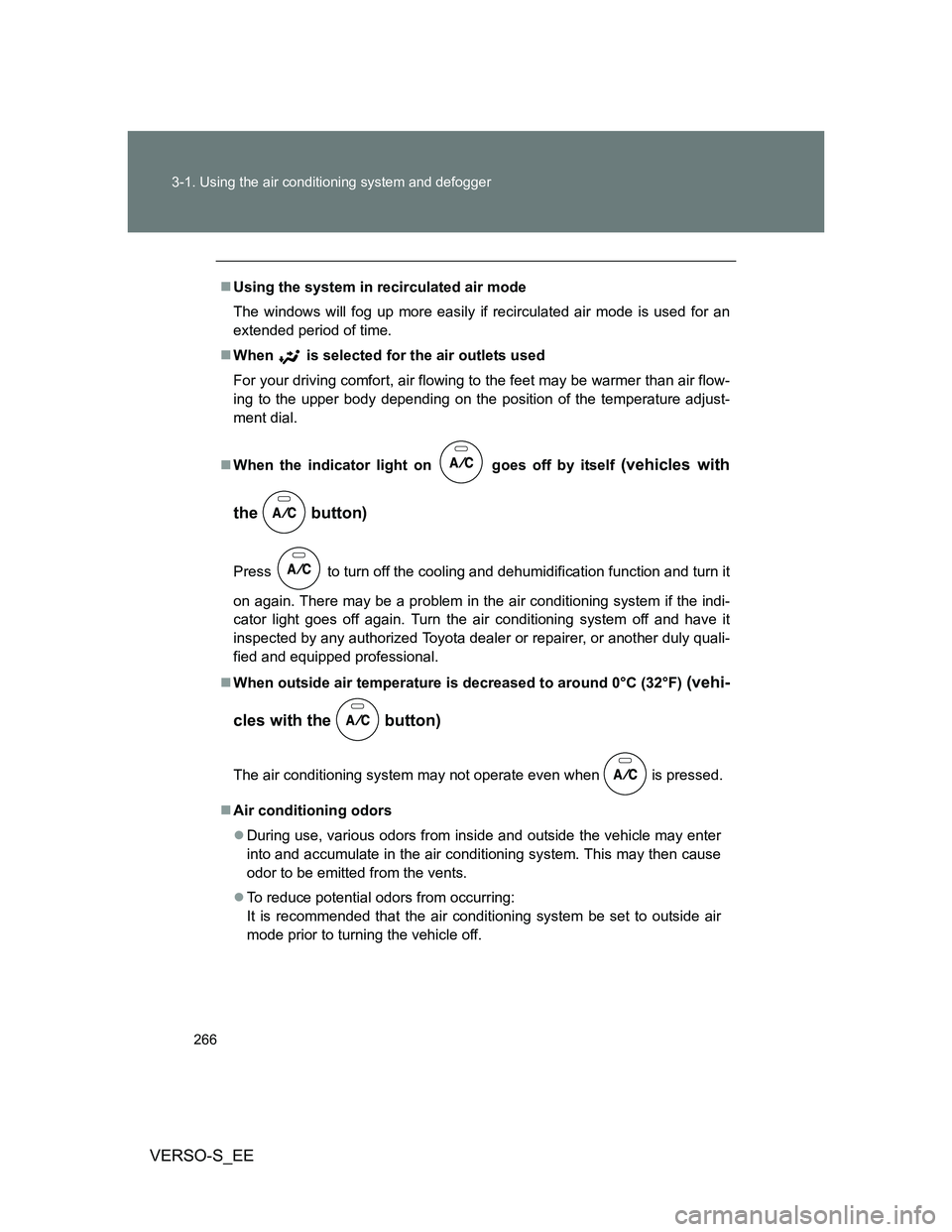2013 TOYOTA VERSO S light
[x] Cancel search: lightPage 241 of 552

241 2-4. Using other driving systems
2
When driving
VERSO-S_EE
CAUTION
The ABS does not operate effectively when
The limits of tire gripping performance have been exceeded (such as
excessively worn tires on a snow covered road).
The vehicle hydroplanes while driving at high speed on wet or slick roads.
Stopping distance when the ABS is operating may exceed that of nor-
mal conditions
The ABS is not designed to shorten the vehicle’s stopping distance. Always
maintain a safe distance from the vehicle in front of you, especially in the fol-
lowing situations:
When driving on dirt, gravel or snow-covered roads
When driving with tire chains
When driving over bumps in the road
When driving over roads with potholes or uneven surfaces
TRC may not operate effectively when
Directional control and power may not be achievable while driving on slip-
pery road surfaces, even if the TRC system is operating.
Be especially careful and drive the vehicle in conditions where stability and
power may be lost.
When the VSC is activated
The slip indicator light flashes. Always drive carefully. Reckless driving may
cause an accident. Exercise particular care when the indicator light flashes.
When the TRC/VSC systems are turned off
Be especially careful and drive at a speed appropriate to the road condi-
tions. As these are the systems to ensure vehicle stability and driving force,
do not turn the TRC/VSC systems off unless necessary.
Page 256 of 552

256 2-5. Driving information
VERSO-S_EE
Tire information
Ensure that your vehicle's tires are properly inflated. Adjust the tire pres-
sure to the recommended pressure. (P. 523)
Increase the air pressure of the trailer tires in accordance with the total
trailer weight and according to the values recommended by the manufac-
turer of your trailer.
Trailer lights
Check that the turn signal lights and stoplights are operating correctly every
time you hitch up the trailer. Directly wiring up to your vehicle may damage
the electrical system and stop the lights from functioning correctly.
Break-in schedule
Toyota recommends that vehicles fitted with new power train components
should not be used for towing trailers for the first 800 km (500 miles).
Safety checks before towing
Check that the maximum load limit for the towing hitch/bracket and hitch
ball is not exceeded. Bear in mind that the coupling weight of the trailer
will add to the load exerted on the vehicle. Also make sure that the total
load exerted on the vehicle is within the range of the weight limits.
(P. 252)
Ensure that the trailer load is secure.
Supplementary outside rear view mirrors should be added to the vehicle
if the traffic behind cannot be clearly seen with standard mirrors. Adjust
the extending arms of these mirrors on both sides of the vehicle so that
they always provide maximum visibility of the road behind.
Maintenance
Maintenance must be performed more frequently when using the vehicle
for towing due to the greater weight burden placed on the vehicle com-
pared to normal driving.
Retighten all bolts securing the hitching ball and bracket after towing for
approximately 1000 km (600 miles).
Page 257 of 552

257 2-5. Driving information
2
When driving
VERSO-S_EE
Guidance
Your vehicle will handle differently when towing a trailer. In order to
avoid accident, death or serious injury, keep the following in mind
when towing:
Checking connections between trailer and lights
Stop the vehicle and check the operation of the connection
between the trailer and lights after driving for a brief period as well
as before starting off.
Practicing driving with a coupled trailer
Get the feel for turning, stopping and reversing with the trailer
coupled by practicing in an area with no or light traffic.
When reversing with a coupled trailer, hold the section of the
steering wheel nearest to you and rotate clockwise to turn the
trailer left or counterclockwise to turn it right. Always rotate a lit-
tle at a time to prevent steering error. Have someone guide you
when reversing to lessen the risk of an accident.
NOTICE
When the rear bumper strengthening material is aluminum
Ensure the steel bracket part does not come directly in contact with that
area.
When steel and aluminum come into contact, there is a reaction similar to
corrosion, which will weaken the section concerned and may result in dam-
age. Apply a rust inhibitor to parts that will come in contact when attaching a
steel bracket.
Page 259 of 552

259 2-5. Driving information
2
When driving
VERSO-S_EETransmission information
Vehicles with a Multidrive and multi-mode manual transmis-
sion
Select an appropriate gear in M mode to maintain the effectiveness
of engine braking and to maintain charging system performance.
Vehicles with a manual transmission
Refrain from driving in 6th gear to maintain the effectiveness of
engine braking and to maintain charging system performance.
If the engine overheats
Towing a loaded trailer up a long, steep incline in temperatures
exceeding 30C (85F) may result in the engine overheating. If the
high engine coolant temperature warning light flashes or comes
on, turn the air conditioning off immediately, leave the road and
stop the vehicle in a safe place. (P. 497)
When parking the vehicle
Always place wheel chocks under the wheels of both the vehicle
and trailer. Firmly set the parking brake and shift the shift lever to P
for Multidrives, E, M or R for multi-mode manual transmissions,
and 1 or R for manual transmissions.
Page 261 of 552

3Interior features
261
VERSO-S_EE
3-1. Using the air conditioning
system and defogger
Manual air conditioning
system ............................ 262
Automatic air conditioning
system ............................ 268
Power heater .................... 274
Rear window and
outside rear view
mirror defoggers ............. 276
3-2. Using the audio system
Audio system types .......... 278
Using the radio ................. 282
Using the CD player ......... 286
Playing back MP3 and
WMA discs...................... 291
Operating an iPod............. 298
Operating a USB
memory........................... 306
Optimal use of the audio
system ............................ 314
Using the AUX port ........... 316
Using the steering wheel
audio switches ................ 3173-3. Using the interior lights
Interior lights list ................ 320
• Personal lights ................ 321
• Personal/interior lights .... 321
• Interior light ..................... 322
3-4. Using the storage
features
List of storage features ..... 323
• Auxiliary box ................... 324
• Glove box ....................... 324
• Bottle holders.................. 326
• Tray ................................ 327
• Cup holders .................... 328
3-5. Other interior features
Sun visors ......................... 329
Vanity mirrors.................... 330
Clock ................................. 331
Outside temperature
display ............................ 332
Power outlets .................... 333
Seat heaters ..................... 335
Armrests ........................... 337
Panoramic roof shade....... 338
Assist grips ....................... 341
Floor mat........................... 342
Luggage compartment
features........................... 344
Page 266 of 552

266 3-1. Using the air conditioning system and defogger
VERSO-S_EE
Using the system in recirculated air mode
The windows will fog up more easily if recirculated air mode is used for an
extended period of time.
When
is selected for the air outlets used
For your driving comfort, air flowing to the feet may be warmer than air flow-
ing to the upper body depending on the position of the temperature adjust-
ment dial.
When the indicator light on goes off by itself
(vehicles with
the button)
Press to turn off the cooling and dehumidification function and turn it
on again. There may be a problem in the air conditioning system if the indi-
cator light goes off again. Turn the air conditioning system off and have it
inspected by any authorized Toyota dealer or repairer, or another duly quali-
fied and equipped professional.
When outside air temperature is decreased to around 0°C (32°F)
(vehi-
cles with the button)
The air conditioning system may not operate even when is pressed.
Air conditioning odors
During use, various odors from inside and outside the vehicle may enter
into and accumulate in the air conditioning system. This may then cause
odor to be emitted from the vents.
To reduce potential odors from occurring:
It is recommended that the air conditioning system be set to outside air
mode prior to turning the vehicle off.
Page 272 of 552

272 3-1. Using the air conditioning system and defogger
VERSO-S_EE
Using the automatic mode
Fan speed is adjusted automatically in accordance with the temperature set-
ting and ambient conditions. As a result, the following may occur.
Immediately after
is pressed, the fan may stop for a while until
warm or cool air is ready to flow.
Cool air may flow to the area around the upper body when the heater is
on.
Switching between outside air and recirculated air modes
Recirculated air mode or outside air mode may be automatically switched to
in accordance with the temperature setting and the inside temperature.
Using the system in recirculated air mode
The windows will fog up more easily if recirculated air mode is used.
Window defogger feature
Recirculated air mode may automatically switch to
(outside air)
mode in situations where the windows need to be defogged.
When the indicator light on goes off by itself
Press to turn off the cooling and dehumidification function and turn it
on again. There may be a problem in the air conditioning system if the indi-
cator light goes off again. Turn the air conditioning system off and have it
inspected by any authorized Toyota dealer or repairer, or another duly quali-
fied and equipped professional.
When outside air temperature is decreased to around 0C (32F)
The air conditioning system may not operate even when is pressed.
When
is selected for the air outlets used
For your driving comfort, air flowing to the feet may be warmer than air flow-
ing to the upper body depending on the temperature setting.
Page 274 of 552

274
3-1. Using the air conditioning system and defogger
VERSO-S_EE
Power heater
Power heater can be operated when
The engine is running.
Normal characteristics of power heater operation
The following cases do not indicate a malfunction:
When the power heater is turned on or off, some white smoke and a
slight odor may be emitted from the power heater exhaust that is located
under the floor.
When the power heater is used under extremely cold conditions, vapor
may be visible from its exhaust.
When the power heater is turned off, you may hear a sound in the engine
compartment for about 2 minutes until the power heater turns off com-
pletely.
After the heater is turned off
We recommend not restarting the heater for 10 minutes after you turn it off.
Otherwise, a noise may be heard as the heater ignites.
When refueling your vehicle
The engine must be turned off. Turning the engine off turns the power heater
off.
: If equipped
This feature is used to keep the cabin warm in cold conditions.
Turns the power heater on/off
The power heater turns on
about 25 seconds after the but-
ton is pressed, and takes
about another 85 seconds to
warm up.